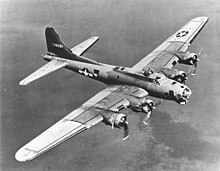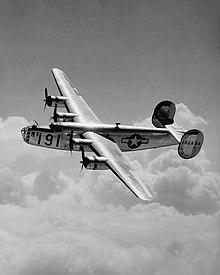966th Airborne Air Control Squadron
966th Airborne Air Control Squadron
 | |
|---|---|
 552d Air Control Wing Boeing E-3 Sentry | |
| Active | 1942–1944; 1944–1945; 1961–1969; 1976–present |
| Country | |
| Branch | |
| Role | Airborne command and control training |
| Part of | Air Combat Command |
| Garrison/HQ | Tinker Air Force Base |
| Motto(s) | Protection by Professionals (1963-1989) Sweat more... Bleed Less (2013-present)[citation needed] |
| Engagements | China-Burma-India Theater[1] |
| Decorations | Air Force Outstanding Unit Award with Combat "V" Device Air Force Outstanding Unit Award Republic of Vietnam Gallantry Cross with Palm[1] |
| Commanders | |
| Current commander | Lt Col Asif Kausar |
| Insignia | |
| 966th Airborne Air Control Squadron emblem[a][2][1] |  |
| 966th Airborne Early Warning & Control Squadron emblem[b][2] |  |
The 966th Airborne Air Control Squadron is an active United States Air Force unit is assigned to the 552d Air Control Wing at Tinker Air Force Base, Oklahoma. It operates the Boeing E-3 Sentry Airborne Warning and Control System aircraft conducting training of crews in airborne command and control missions.
The squadron's first predecessor is the 466th Bombardment Squadron which served during World War II as an Operational Training Unit, and later as a Replacement Training Unit. It was disbanded in the spring of 1944 in a general reorganization of Army Air Forces support and training units in the United States.
Mission
[edit]The squadron is the Boeing E-3 Sentry formal training unit (FTU) for all Airborne Warning and Control System aircrew.[3][4] It is Air Combat Command's largest flying training unit, providing training for all active and reserve E-3 pilots and mission crew, training approximately 500 students every year.[5] It provides the combat Air Force with airborne systems and personnel for surveillance, warning and control of strategic, tactical, and special mission forces.[6]
History
[edit]World War II
[edit]Bomber training
[edit]
The first predecessor of the squadron, the 466th Bombardment Squadron was activated on 15 July 1942 at Topeka Army Air Base, Kansas as one of the four original squadrons of the 333d Bombardment Group.[7][8][9] In August, it began operating as an Operational Training Unit (OTU) for Boeing B-17 Flying Fortress units. The OTU program involved the use of an oversized parent unit to provide cadres to "satellite groups"[10] The OTU program was patterned after the unit training system of the Royal Air Force. The parent assumed responsibility for satellite unit training and oversaw their expansion with graduates of Army Air Forces Training Command schools to become effective combat units.[11][12] Phase I training concentrated on individual training in crewmember specialties. Phase II training emphasized the coordination for the crew to act as a team. The final phase concentrated on operation as a unit.[13] Later that year, the squadron traded its Flying Fortresses for Consolidated B-24 Liberators.[7]

In February 1943, the squadron moved to Dalhart Army Air Field, Texas. However, many of the Army Air Forces' bomber units had been activated. With the exception of special programs, like forming Boeing B-29 Superfortress units, training “fillers” for existing units became more important than unit training.[14] The squadron mission changed to becoming a Replacement Training Unit (RTU). RTUs were also oversized units, but their mission was to train individual pilots or aircrews.[15] It continued this mission through November 1943.[7]
The AAF was finding that standard military units like the 466th, whose manning was based on relatively inflexible tables of organization were proving not well adapted to the training mission, even more so to the replacement mission. Accordingly, the Army Air Forces adopted a more functional system in which each base was organized into a separate numbered unit.[16] The 466th and other training and support units at Dalhart were disbanded or inactivated on 1 April 1944[7] and replaced by the 232d AAF Base Unit. In 1985, the squadron was reconstituted and consolidated with the active 966th Airborne Warning and Control Training Squadron.[1]
Special operations
[edit]Flew evacuation missions and light transport services for ground forces in Burma from 13 November 1944 – 10 May 1945.[1]
Airborne warning and control
[edit]It provided airborne radar surveillance from 1962 to 1969 and rotated aircrews to Southeast Asia from c. 4 April 1965 – c. December 1969. The 966th has trained aircrews since 1977.[1]
Lineage
[edit]- 466th Bombardment Squadron
- Constituted as the 466th Bombardment Squadron (Heavy) on 9 July 1942
- Activated on 15 July 1942
- Inactivated on 1 April 1944
- Consolidated with the 166th Liaison Squadron and the 966th Airborne Warning and Control Training Squadron as the 966th Airborne Warning and Control Training Squadron on 19 September 1985[1]
- 166th Liaison Squadron
- Constituted as the 166th Liaison Squadron (Commando) on 9 August 1944
- Activated on 3 September 1944
- Inactivated on 3 November 1945
- Consolidated with the 466th Bombardment Squadron and the 966th Airborne Warning and Control Training Squadron as the 966th Airborne Warning and Control Training Squadron on 19 September 1985[1]
966th Airborne Air Control Squadron
- Constituted as the 966th Airborne Early Warning and Control Squadron and activated on 18 December 1961 (not organized)
- Organized on 1 February 1962
- Inactivated on 31 December 1969
- Redesignated 966th Airborne Warning and Control Training Squadron on 5 May 1976
- Activated on 1 July 1976
- Consolidated with the 166th Liaison Squadron and the 466th Bombardment Squadron on 19 September 1985
- Redesignated 966th Airborne Air Control Squadron on 1 July 1994[1]
Assignments
[edit]- 333d Bombardment Group, 15 July 1942 – 1 April 1944
- 1st Air Commando Group, 3 September 1944 – 3 November 1945
- Air Defense Command, 18 December 1961 (not organized)
- 551st Airborne Early Warning and Control Wing, 1 February 1962
- 552d Airborne Early Warning and Control Wing, 1 May 1963
- 551st Airborne Early Warning and Control Wing, 1 July 1969
- 552d Airborne Early Warning and Control Wing, 15 November-31 December 1969
- 552d Airborne Warning and Control Wing (later 552d Airborne Warning and Control Division; 552d Airborne Warning and Control Wing; 552d Air Control Wing), 1 July 1976
- 552d Operations Group, 29 May 1992 – present[1]
Stations
[edit]
|
|
Aircraft
[edit]
|
|
Operations
[edit] |

| ||
| B-17 Flying Fortress (1942) |
B-24 Liberator (1943–1944) |
L-5 Sentinel (1944–1945) |
UC–64 Norseman (1944–1945) |
 |
 |
 |

|
| RC-121 (1962–1963) |
EC-121 Warning Star (1963–1969) |
WC-135 (1977–1979) |
E-3 Sentry (since 1977) |
References
[edit]Notes
[edit]- Explanatory notes
- ^ Approved 14 May 1989. Description: Per bend Celeste and Sable a lightning flash issuant from base bendwise throughout Gules fimbriated Or surmounted by an eagle proper and grasping in both feet a telescope Argent garnished Yellow above a wreath of laurel of the last [color mentioned]; all within a diminished bordure of the second [color mentioned].
- ^ Approved 14 June 1963. The 1989 revision added a laurel wreath
- Citations
- ^ a b c d e f g h i j k l "Factsheet 966 Airborne Air Control Squadron". Air Force Historical Research Agency. 31 March 2008. Retrieved 4 January 2021.
- ^ a b Endicott, p. 904
- ^ Unknown. "Unit Spotlight on 966th Airborne Air Control Squadron". The Journal Record. Retrieved 8 March 2020.[dead link]
- ^ Rangel, 2Lt Danny (11 May 2020). "966th Airborne Air Control Squadron Continues Mission Despite COVID-19". 72nd Air Base Wing Public Affairs. Retrieved 3 January 2021.
{{cite web}}: CS1 maint: numeric names: authors list (link) - ^ "966 Airborne Air Control Squadron" (PDF). USAF Unit History. 18 March 2020. Retrieved 8 March 2020.{{dead link|date=August 2024
- ^ "Library: Factsheets 552nd Operations Group". 552nd Air Control Wing Public Affairs. 1 June 2007. Archived from the original on 22 July 2011. Retrieved 4 January 2021.
- ^ a b c d Maurer, Combat Squadrons, p 572
- ^ Maurer, Combat Units, pp.213-14
- ^ Maurer, Combat Squadrons, pp. 573-575
- ^ Craven & Cate, Introduction, p. xxxvi
- ^ Goss, p. 74
- ^ Greer, p. 601
- ^ Greer, p. 606
- ^ Goss, pp. 74-75
- ^ Craven & Cate, Introduction, p. xxxvi
- ^ Goss, p. 75
Bibliography
[edit]![]() This article incorporates public domain material from the Air Force Historical Research Agency
This article incorporates public domain material from the Air Force Historical Research Agency
- Craven, Wesley F.; Cate, James L., eds. (1955). The Army Air Forces in World War II (PDF). Vol. VI, Men & Planes. Chicago, IL: University of Chicago Press. LCCN 48003657. OCLC 704158. Retrieved 17 December 2016.
- Goss, William A. (1955). "The Organization and its Responsibilities, Chapter 2 The AAF". In Craven, Wesley F.; Cate, James L. (eds.). The Army Air Forces in World War II (PDF). Vol. VI, Men & Planes. Chicago, IL: University of Chicago Press. LCCN 48003657. OCLC 704158. Retrieved 17 December 2016.
- Greer, Thomas H. (1955). "Recruitment and Training, Chapter 18 Combat Crew and Unit Training". In Craven, Wesley F.; Cate, James L. (eds.). The Army Air Forces in World War II (PDF). Vol. VI, Men & Planes. Chicago, IL: University of Chicago Press. LCCN 48003657. OCLC 704158. Retrieved 17 December 2016.
- Endicott, Judy G. (1998). Active Air Force Wings as of 1 October 1995 and USAF Active Flying, Space, and Missile Squadrons as of 1 October 1995 (PDF). Air Force History and Museums Program. Washington, DC: Office of Air Force History. ASIN B000113MB2. Retrieved 2 July 2014.
- Maurer, Maurer, ed. (1983) [1961]. Air Force Combat Units of World War II (PDF) (reprint ed.). Washington, DC: Office of Air Force History. ISBN 0-912799-02-1. LCCN 61060979. Retrieved 17 December 2016.
- Maurer, Maurer, ed. (1982) [1969]. Combat Squadrons of the Air Force, World War II (PDF) (reprint ed.). Washington, DC: Office of Air Force History. ISBN 0-405-12194-6. LCCN 70605402. OCLC 72556.
- Ravenstein, Charles A. (1984). Air Force Combat Wings, Lineage & Honors Histories 1947-1977 (PDF). Washington, DC: Office of Air Force History. ISBN 0-912799-12-9. Retrieved 17 December 2016.


